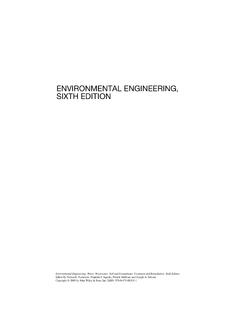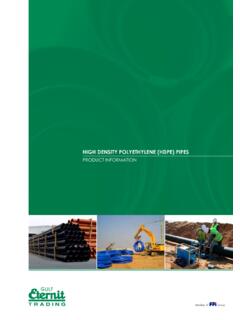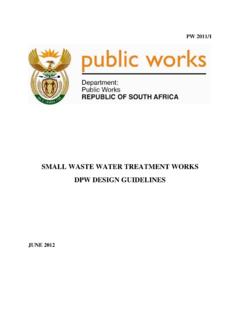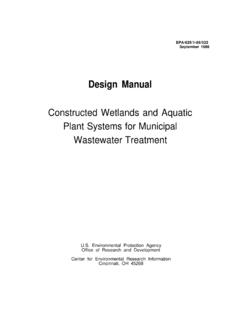Transcription of Design Manual: Onsite Wastewater Treatment and …
1 I I I I I I I I I EPA 625/1-80-012 Design MANUALONSITE Wastewater Treatment AND disposal SYSTEMS ENVIRONMENTAL PROTECTION AGENCY Off iice of Water Program Operations Office of Research and Development municipal Envi ronmental Research Laboratory October 1980 NOTICE The mention of trade names or commercial products in this publication is for illustration purposes and does not constitute endorsement or recommendation for use by the U. S. Environmental Protection Agency. ii FOREWORD Rural and suburban communities are confronted with problems that are unique to their size and population density, and are often unable to superimpose solutions typically applicable to larger urban areas.
2 A good example of such problems is the provision of Wastewater services. In the past, priorities for water pollution control focused on the cities, since waste generation from these areas was most evident. In such hi gh-densi ty development, the tradi tional sanitary engi neeri ng approach was to construct a network of sewers to convey Wastewater to a central location for Treatment and disposal to surface waters. Since a large number of users existed per unit length of sewer line, the costs of construction and operation could be divided among many people, thus keepi ng the financial burden on each user relatively low.
3 Within the past several decades, migration of the population from cities to suburban and rural areas has been significant. With this shift came the problems of providing utility services to the residents. Unfortunately, in many cases, solutions to Wastewater problems in urban areas have been applied to rural communities. With the advent of federal programs that provi de grants for construction of Wastewater faci lities, sewers and centralized Treatment plants were constructed in these low-density rural settings. In many cases the cost of operating and maintaining such facilities impose severe economic burdens on the communi ties.
4 Although Wastewater Treatment and di sposal systems servi ng single homes have been used for many years, they have often been considered an inadequate or temporary sol uti on until sewers could be constructed. However, research has demonstrated that such systems, if constructed and maintained properly, can provide a reliable and efficient means of Wastewater Treatment and disposal at relati vely low cost. This document provi des technical information on onsi te Wastewater Treatment and disposal systems. It does not contain standards for those systems, nor does it contain rules or regulations pertaining to Onsite sy intended audience for this manual includes those involved in the Design , construction, operation, maintenance, and regulation of onsi te Wastewater systems.
5 Director tdmi ni stra tor for Water Program Operations municipal Environmental Research Laboratory iii ACKNOWLEDGMENTS There were three groups of participants involved in the preparation of this manual : (1) the contractor-authors, (2) the contract supervisors,and (3) the technical reviewers. The manual was written by personnel from SCS Engi neers and Rural Systems Engi neeri ng (RSE). Contract supervi sion was provided by Environmental Protection Agency (EPA) personnel from the municipal Construction Division in Washington, , and from the municipal Environmental Research Laboratory in Cincinnati , Ohio.
6 The technical reviewers were experts in certain areas of Onsite waste Treatment and disposal , and included professors, health officials, consultants, and government officials. Each provided technical review of a section or sections of the report. The membership of each group is listed bel ow. CONTRACTOR-AUTHORS: Direction: Curtis J. Schmidt, SCSW illiam C. Boyle, RSE Senior Authors: Ernest V. Clements, Project Manager, SCS Richard J. Otis, RSE Contributing Authors: David H. Bauer, SCS Robert L. Siegrist, E. Jerry Tyler, Davi d E.
7 Stewart, James C. Converse, RSE CONTRACT SUPERVISORS: Project Officers: Robert M. Southworth, OWPO, EPA, Washington, Robert P. G. Bowker, MERL, EPA, Cincinnati, Ohio Revi ewers: James Krei ssl, MERL , EPA, Cinci nnati , Ohio Denis Lussier, CERI, EPA, Cincinnati, Ohio Sherwood Reed, CRREL, COE, Hanover, TECHNICAL REVIEWERS: 1. Michael Hansel - Minnesota Pollution Control Agency 2. Roger Machmeier -University of Minnesota 3. Jack Abney - Parrott, Ely & Hurt, Inc., Lexington, Kentucky 4. William Mellen - Lake County Health Department, Illinois 5.
8 Rei n Laak - University of Connecticut 6. Gary Plews - Washington Department of Social & Health Services 7. B. L. Carlile - North Carolina State University 8. John Clayton - Fairfax County Health Department, Virginia 9. Wi lliam Sharpe - Pennsyl vani a State Uni versi ty 10. Elmer Jones - Department of Agriculture 11. Edwin Bennett - University of Colorado 12. Harry Pence -Virginia Polytechnic Institute 13. Briar Cook Department of Agriculture, Forest Service 14. Marek Brandes -Ontario Ministry of the Environment (Retired) 15.
9 Michael Hines -Illinois State Department of Public Health 16. John Fancy -John Fancy, Inc. , Waldoboro, Maine iv CONTENTS PageChapter -FORWORD iiiACKNOWLEDGEMENTS V CONTENTS vi i LIST OF FIGURES ix LIST OF TABLES xv 1 INTRODUCTION Background
10 1 Purpose 2 Scope 3 2 STRATEGY FOR Onsite system Design Introduction 4 Onsite system Design Strategy 4 3 SITE EVALUATION PROCEDURES Introduction 13 disposal Alternati ves 13 Site Evaluation Strategy 17 References 48 4 Wastewater CHARACTERI Introducti on 50 Residential Wastewater Characteristics 50 Nonresi dential Wastewater Characteri sti cs 57 Predi cti ng Wastewater Characteristi cs 65 References 68 5 Wastewater MODIFICATION Introducti on 70 Water Conservation and Wastewater Flow Reduction 71 Pollutant Mass Reduction 84 Onsite Containment -Holding Tanks 88 Reliability 88















